Test Cases Module is the central repository of test cases. A single test case can be used repeatedly and associated with multiple releases and cycles- avoiding the need to copy test cases. The execution status of test cases is independent per cycle allowing organizations to repeatedly execute the same test case without affecting the test results between separate runs.
With the Test Cases Module you can:
Organize test cases into folders and subfolders
Add and Edit test cases manually
Import test cases from Excel and Jira
Execute test cases for ad-hoc testing
View the status of individual test cases
Link relevant requirements to test cases
The Test Case module screen has the following UI.
All grids within the Requirements, Test Cases, Test Suites, and Issues module have Arrange Columns option that allows users to create a customized view of their test assets.
The view is saved for future use.
The following customization can be applied:
Show More Columns: The ability to add columns in the view. If there are other columns that you think important to display on the module grid apart from the default view, then you can just select those columns to add them to the view.
Hide Columns: The ability to remove a column from view. If you do not want to include columns of less important on the module grid view, then remove column selection to hide those columns on the view.
Users can show/hide the Testing Type field in the Test Case module. If users want to use their own UDF instead of this field, they can hide it. The setting is provided in the Manage Fields section of the Customization module. Refer to Manage Fields for more details.
Re-arrange: The ability to arrange the columns in a different order through drag and drop functionality.
You can search for a particular column through the search box.
Options to select all columns, clear all selected columns and restore default column selection are provided on the Arrange Columns menu.

Resize Columns: The ability to expand and reduce column width. If you want to display the full content of the column, then you may want to change the column width. To change the width of one column, just place the cursor in between the columns and drag the boundary on the right side of the column heading until the column gains the width that you want.

Just click on the Test Case Key in the grid view to open the test case detail page on the same page.
To open the test case detail page in a new tab/window, right-click on the Test Case Key in grid view. Opening test cases in different tab/browser makes a comparison between test cases easier. It also provides quick reference while working on multiple assets.
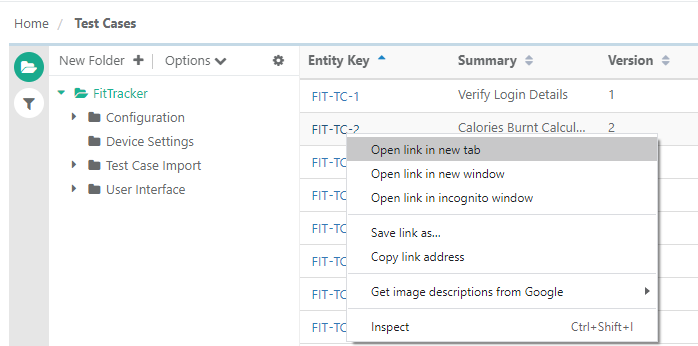
The detail page is redesigned that allows one-click access to different sections using organizable tabs.
Organize Tabs
The detail page of QMetry assets has different tabs on it. Users can customize the view of the detail page by changing the order of tabs. The tab order is preserved per user.
For example, the tab order of the Test Cases module is changed by user "A" for project "PRO1". Now "A" is switching to another project "PRO2". The tabs can be seen in the same order as in project "PRO1".
Combined View vs. Grouped View
A. Individual Section Tabs
B. Combined View (Read-Only View)

A. Individual Section Tabs
For Test Case: There are individual tabs for Steps, Details, Requirements, Release & Cycles, Test Executions, Issues, Version, Attachments, Comments, Change Log
Each tab displays relevant details. The details are editable.
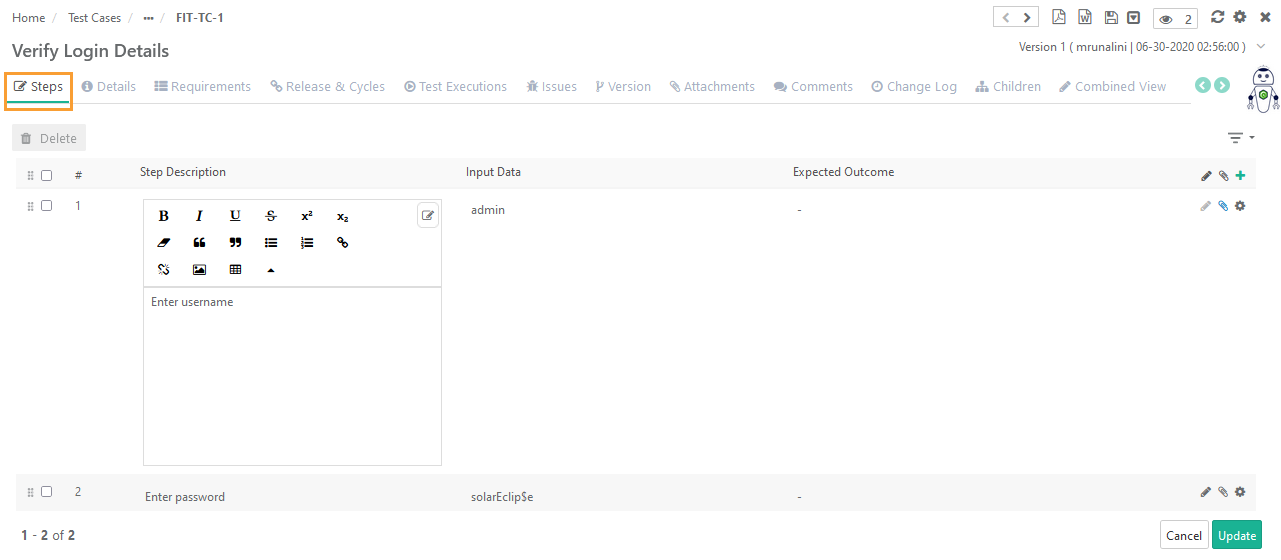
B. Combined View (Read Only View)
The tab renders the old view of the details page. You can view the details of all the sections on a single page. The details displayed on the page are read-only and can not be edited.

The Previous and Next buttons on the detail page are added for ease of navigation and updating the test cases.
Users can easily filter test assets by any system/custom fields on all module grids. It also helps users in carrying out bulk operations. Filters placed horizontally above the grid earlier, are now placed on the tree panel at left.
Testers can view details grid aligned with folder tree even when they are clicking a folder which is at the bottom.
Apply Filter
Users can apply basic as well as advanced filters to the records.
A. Basic Filters: By default, basic filter fields are provided to filter the records.
B. Advanced Filters: If users need more fields to filter test assets then click on the '+' icon. It opens the drop-down with a list of additional system and user-defined fields corresponding to the module.
Select the field you want to apply a filter on. The filter parameter is added as Advanced Filters. Apply filter as per your requirement.
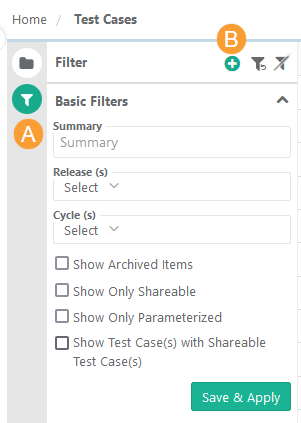
Users can click on the '+' icon and select the field Entity Key to search test cases using comma-separated entity IDs (i.e. without specifying the complete Entity Key as described below).
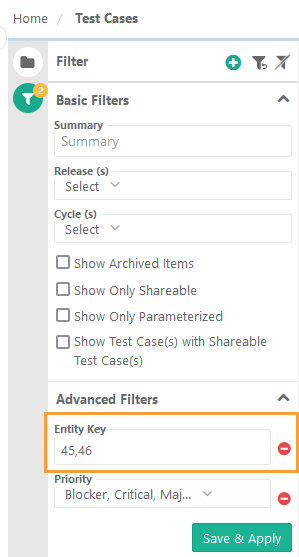
For example,
Users want to filter test assets on Priority, Entity Key, and Status, then click on the '+' icon and select the fields on the drop-down list as shown below.
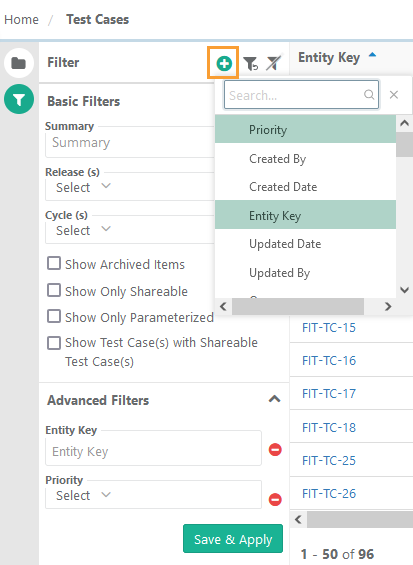
Clear Filter and Sorting
Users can clear the applied filter and sorting to the records.
A. Clear Filter: Click on the Clear Filters button above the module grid or on the left pane. It will reset the view to default.
B. Clear Sorting: Click on the Clear Sorting button above the module grid.

A. Clear Filter Values
The Clear Filter Values option provides users with improved flexibility, efficiency, and usability in managing and reusing Advanced Filters for important data that may not be easily accessible by default. This option only clears out the values in the filters without removing the fields themselves. It enables users to start fresh with the same set of fields, allowing them to adjust their filter criteria without having to recreate the entire filter setup each time. It preserves empty fields in the filter just like fields with values and allows users to easily modify and refine the filter criteria without losing the content of the set fields. Here, empty fields in the filter will consider all records.
B. Reset Filters
The Reset Filters option will reset the filter to default. All the selected fields for Advanced Filter will be removed from the filter.

Users can opt to include or exclude test assets from sub folders at parent folder. By default, Include Entities from Sub-folder remains selected, and entities from sub-folders are displayed at parent folder level on the module list view.
To hide the entities from sub-folder, open the Options drop-down on the test asset tree at left, and select deselect Include Entities from Sub-Folder.

Once you are on the test case details page, you can go back to the main screen of test cases by clicking on the breadcrumbs.

Test cases are added at the Project level. The Test Case module main screen displays test cases in the Project as per folder selection. You can apply a filter to the columns as mentioned above. Multiple columns can be filtered at once to help users find the required test cases.
QMetry allows testers to organize and manage test cases in a Folder-based hierarchy. Testers can group related test cases and organize them systematically during authoring or post-authoring.
It helps to carry out bulk operations like Move, Copy, Editing, Deleting, and Executing all test cases under one folder.
The count of test assets in the folder hierarchy is displayed alongside the folder name. The count includes active + archived test cases + shareable test cases.
For example, this is the folder hierarchy: Folder A → Folder B → Folder C
Folder A has 5 test cases, Folder B has 3 test cases, and Folder C has 2 test cases, then the count will be displayed as follows.
Folder A (10) <------ Parent Folder
Folder B (5) <------Child Folder
Folder C (2) <------Subfolder of Child Folder

The tree/folder panel is expandable which facilitates stretching of the area if you want to view longer folder names. You can also hover over the folder to view its full name.
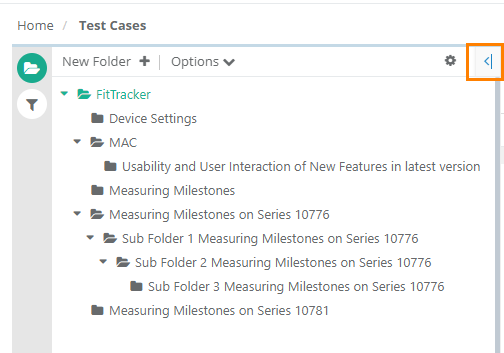
On the Test Case module toolbar, click on the New Folder button to add a new test case folder.
Enter the following fields to add a new folder:
Folder Name: Enter the name of the folder.
Click Create. The new folder is reflected on the tree.
Note: The following permissions related to the Test Case module are set from User Role for individual roles.
View
Modify
Create
Delete
Import
Export
Link
Copy
Versioning
Make sure you have relevant rights to carry out the operation.
Select the folder on the tree and click on the Edit icon on the toolbar.
The folder detail screen opens in editable mode.
Select the folder on the tree and click on the Delete icon on the toolbar.
On deleting a folder, all the subfolders and entities within the folder will be deleted. The status of the parent folder will get re-calculated in all the scopes that this folder was present in. The root folder cannot be deleted.
On the Test Case module toolbar, click on the New button.
The Add Test Case screen has the following fields on it.
Summary: Enter the name of the test case.
Priority: Select an option from the list.
Labels: You can select multiple options from the list.
Status: Select an option from the list, which contains values like New, Approved, In Progress, Ready to Review, etc. The list is customizable. Users can add more list values from Customization > Lists.
Use Case: Tester writes a test case based on requirement specifications and assigns this test case to the Testing Lead with the status “New”. The Testing Lead then reviews the test case and assigns the status “Reviewed” or “Ready”, if the test case is written properly.
Owner: The drop-down list contains QMetry users having rights to the current Project. Select the owner of the test case who will be executing it.
Test Case Category: Select an option from the list e.g. Regression, Performance, Security.
Estimated Time (In Minutes): Mention the estimated execution time of the test case in minutes.
Description: Enter a description regarding the test case. Test Case Description can be added in either Plain Text or Rich Text.
Rich Text:
A. Use of Rich Text Editor allows users to apply text formatting for Test Case Description and reduces chances of missing important details. Users can also insert images, hyperlinks and tables to the field.
Image Upload Support in Rich Text Editor:
Users can add images to any Large Rich Text Editor field (System as well as Custom) up to 1 MB. The images can be uploaded in the fields (A) by browsing and uploading the image (B) by inserting the image through the URL. (C) by copying and pasting the image directly into the editor/text field without saving it first on the local machines. Multiple images can be copied and pasted at a time.
It is applicable to all the fields across QMetry wherever the rich text editor is available.
You can preview the image just by clicking on it.
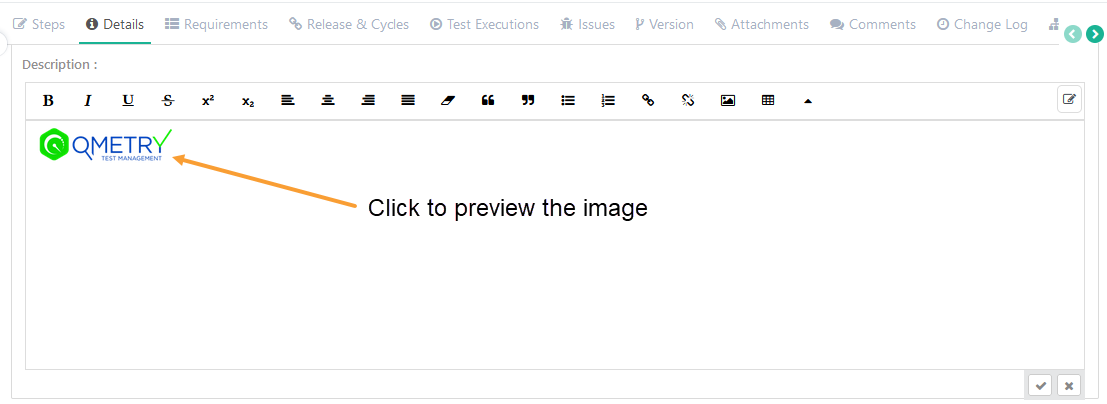
To download the image, click on the image and then click on the Download icon at the top right corner.

Notes:
The supported file formats to upload/copy-paste the image are jpg, jpeg, png, and gif.
The maximum file size should be 1 MB (for images uploaded through browsing).
B. Users can paste the html/xml content into the Source editor of the "Large Text" field type and it auto-renders the code to show the text outputs on the screen.
Use Case: An organization is using Rich text for Description field, in which they copy-paste the content from their source in html/xml format.
Click on the Edit icon at the right to open the source editor.
Note: To enable a rich text editor, the Enable Rich Text parameter should be enabled for the Project (Projects > Project / Release / Cycle). Refer to Enable Rich Text Editor for more details.
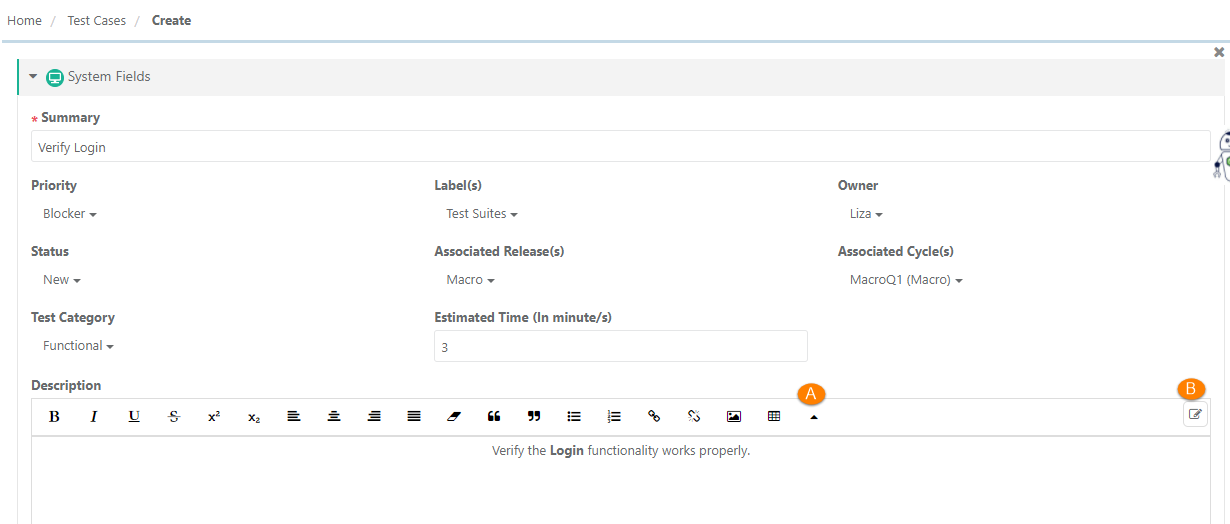
Testing Type: You can see this field on the test case detail page once a test case is created. The field shows how the test case was created in QMetry: Manual or Automated. If a test case is created through UI or imported from Excel, then it is identified as a manual test case. Test Cases that are created through Automation APIs are identified as Automated test cases. The Testing Type field remains read-only.
User Defined Fields: If UDFs are added for the test case module, then they are displayed on the Create Test Case screen and Test Case Details screen.
Enable Rich Text and Source Code Editor: Refer to the Description field above.
You can add test steps that are to be executed under the test case. View, Create, Edit and Delete rights for Test Case are allocated to user roles from Customization > Roles. Users can perform operations as per the permission granted to their user roles.
Steps
Go to the Steps section on the Create Test Case screen.
Follow either of the following ways to add a test step:
Hover the mouse over the Step Description cell and click on the Edit icon (pencil). You can also move using TAB on the keyboard.
Click on the "+" icon at the right and select the Insert Row option to insert a new step at the end.
Click on the settings icon for the test step and select the Insert Row option to insert a new step next to the current step.
A blank row is added to the grid with auto-generated Step number. Enter Step Description, Input Data and Expected Outcome in respective fields by clicking in the cell.
Repeat the same process to add other steps.

Rich Text Editor for Steps
There are two formats in which you can add test steps: Plain Text and Rich Text.
Enable Rich Text and Source Code Editor: Refer to the Description field of test case.
Note: To enable rich text editor, the Enable Rich Text parameter should be enabled for the Project (Projects > Project / Release / Cycle). Refer to Enable Rich Text Editor for more details.
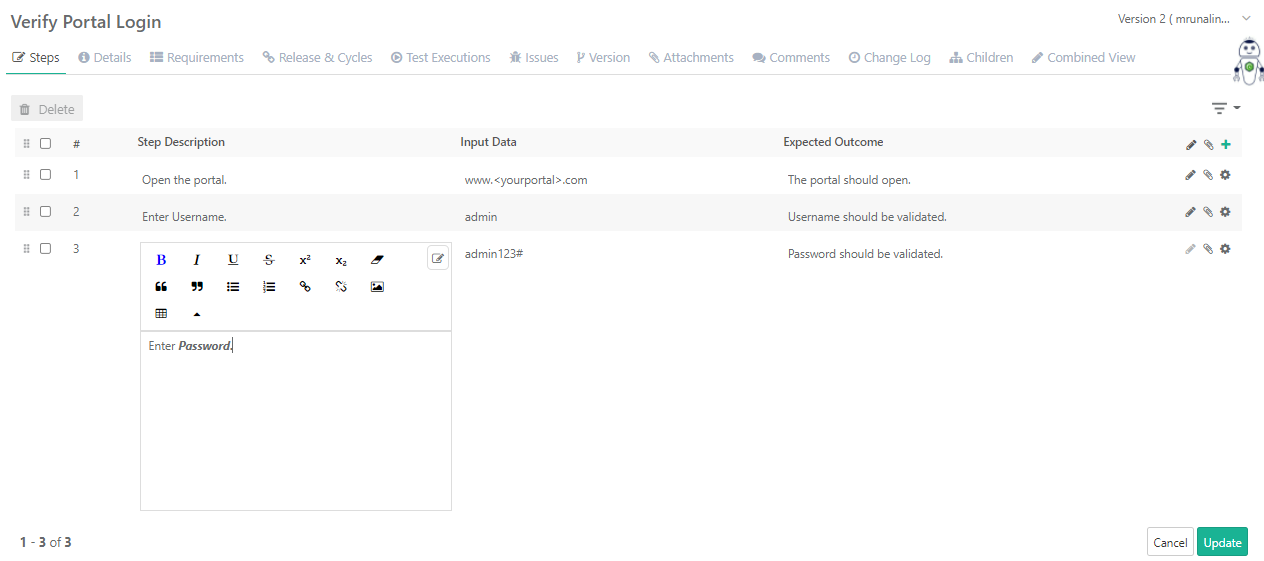
User Defined Fields: If UDFs are added to the test step module, then they are displayed on the Test Steps section as columns beside the default fields of test steps.

Show/Hide and Re-arrange Test Step Columns
You can organize the test steps columns in the panel through drag and drop operation. You can also opt to hide/show Input Data, Expected Outcome and other UDF columns on the screen.
Click Save once you make any changes for the Test Steps panel.

Any changes in test steps column arrangement will reflect in other places where the test steps panel is used. For example, column arrangement changes on the Execution screen will reflect in the following places.
Test Case Create page
Test Case Detail Page
Create New Version page
Exploratory testing
Edit entered steps
1. Click on the Edit button.
2. Click in the cell to modify the steps. It opens the test case details page in editable mode.

It allows you to do inline editing in the field.

As an alternate way, you can click on the Edit icon for the step that you want to edit.

The step section opens in the expanded view with system fields (Step Description, Input Data and Expected Outcome) as well as custom fields.
You can switch between the fields.
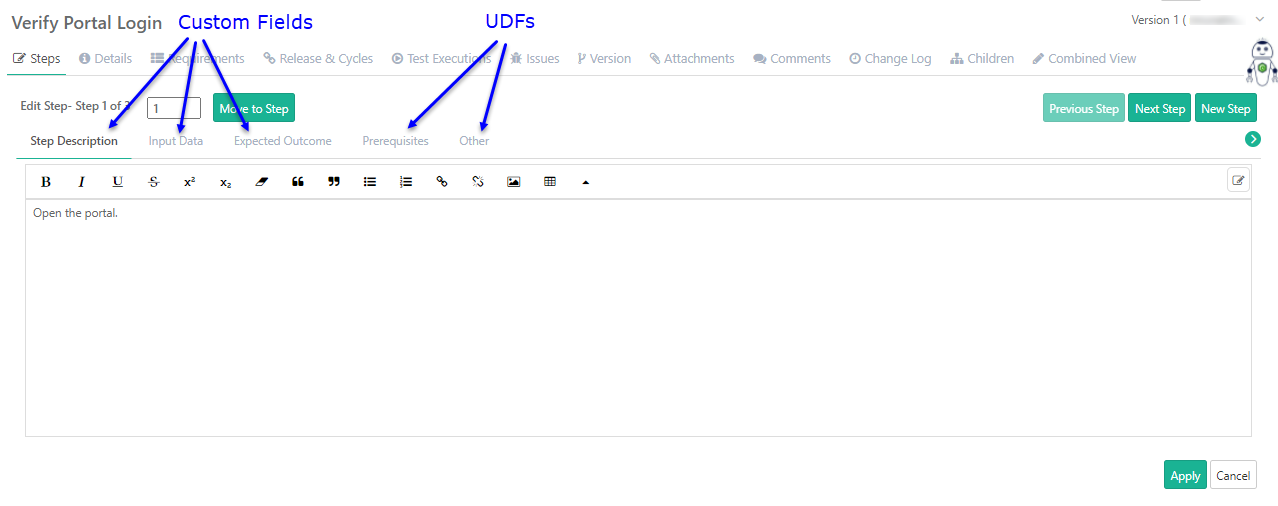
In expanded view, the Large Text UDFs have separate tabs while all the other UDFs are combined in single tab named Other.
The Large Text type UDFs open in separate tabs for edit same as test step system fields.
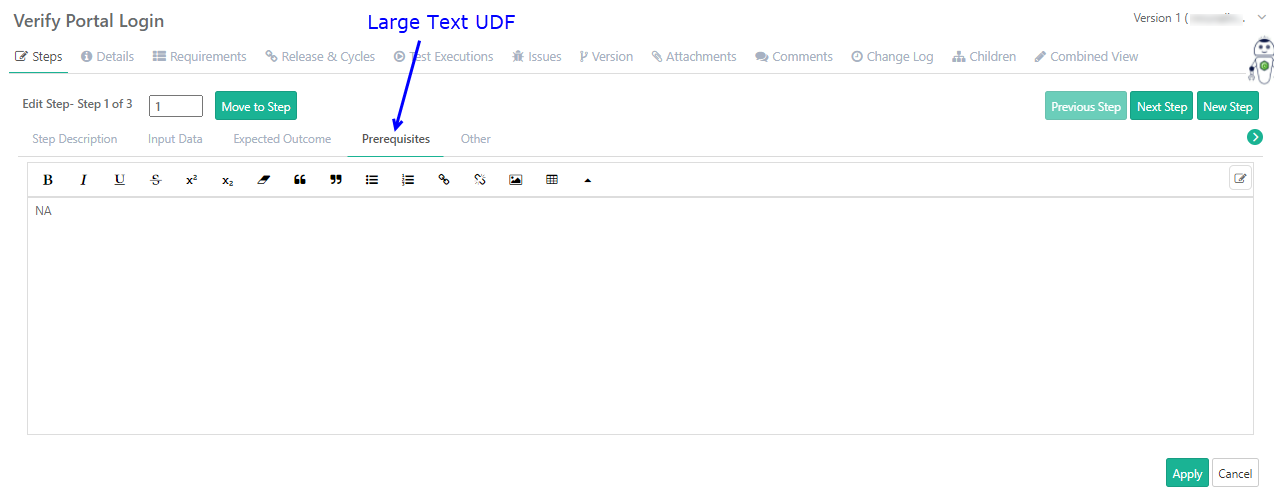
Other tab: UDFs other than Large Text appear in a combined view, where you can edit the fields inline.

To go back to the Step Description section, click on the Move to Step button.
You can use the Previous Step and Next Step buttons to navigate to the previous/next steps.
Use the New Step button to add a new step next to the current step.
Once you are done with editing the test step, click Apply to save the changes.
Actions on Cog icon
You can you to perform the following actions on the Steps grid:
Insert Row
Insert Shareable Test Case
Remove Row
Duplicate Row
Move: Select Index to move the step to.
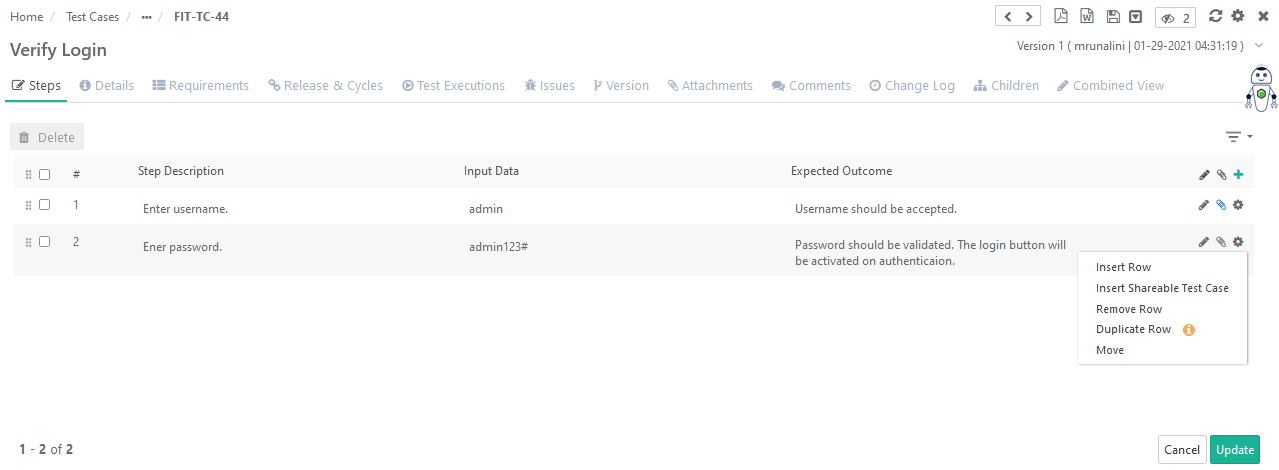
Click on the Create button to save the test case.
When you open the test case detail page, the Test Case Folder Path displays the path up to the folder the test case lies within.
Removing Test Case Steps
Open the test case details page in editable mode.
On the Test Case Step(s) grid, click the Con icon for the step you want to remove.
Select Remove Row.
Changing Order of Test Case Steps
While executing test suite, the test case steps appear in the same sequence as you arranged them here for the test case.
You can easily change the order of test case steps through the following way:
On the Steps tab, click on the Con icon at right and select Move.
Select Index to move the step to.
Users can get more granular details by adding attachments at test steps. For example, a test step needs to be tested with different test data. The tester attaches an excel sheet containing the test data to keep it ready for execution.
Note: Attachments to test steps can be added on the test case detail page as well as on the test case edit page.
To add attachments to the test step level, follow the steps mentioned below:
Go to the test case detail page.
Open the Steps tab.
Click on the Attachment icon for the test step to which you want to add an attachment.

The Add Attachment screen opens. Attach required files to the step.
For attachments added from steps level, the Attachment Level shows “Test Step”.
Download Attachments:
To download a single attachment, click on the Download icon for that attachment.
To download all attachments at a time, click on the Download All button. You can download the zip from the Schedule Task section that can be accessed by clicking on the icon on the application header.
Delete Attachments:
To delete a single attachment, click on the Delete icon for that attachment.
To delete attachments, select and click on the Delete Selected button.
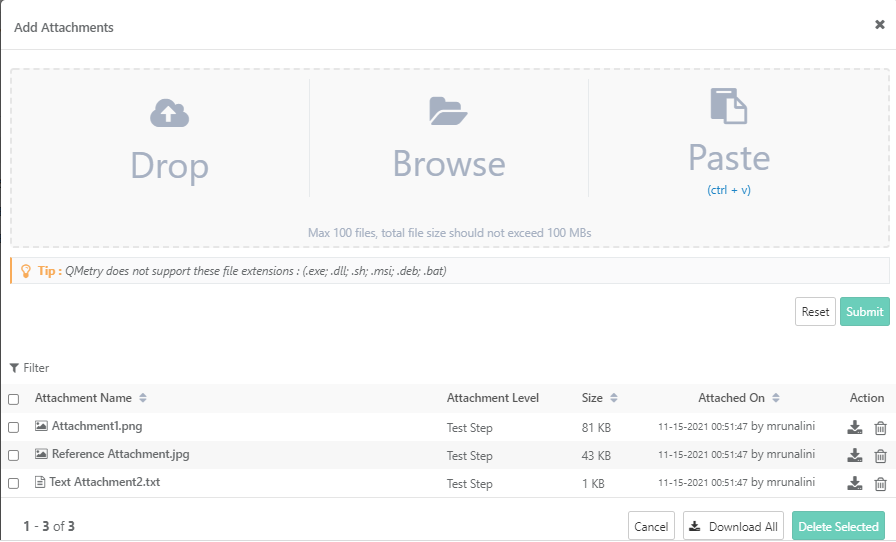
A test case can be edited in terms of its parameters and test case steps.
Users can save the test case without creating its new version. In-place editor is provided on the detail screens for all test assets. Just hover over the field and click on the edit icon.
It opens the field in editable mode. In case of text field, enter the value and save the details.
In-place edit will always update the test asset.
To create a new version of test asset, follow the steps mentioned below.
Edit Test Case Steps
Refer to the Edit entered steps section described earlier on this page.
Delete Test Case Steps
1. Go to the test case detail page.
2. Open the Steps tab and click on the Edit button.

→ Delete/Remove a Single Test Case Step
On the Test Case Step(s) grid, click the Cog icon for the step you want to remove.
Select Remove Row.
Click Update.
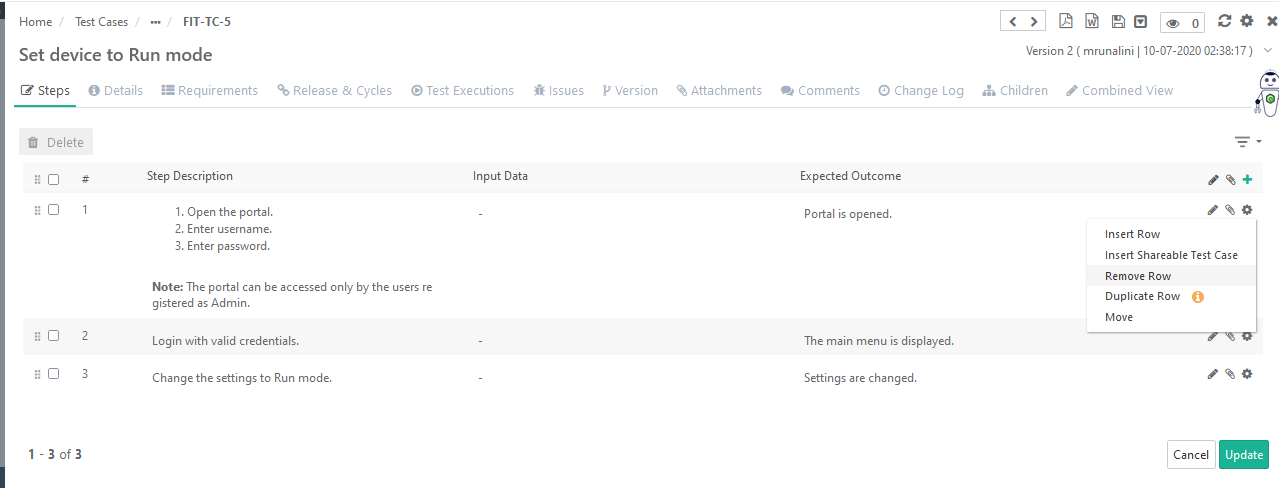
→ Delete/Remove Test Steps in Bulk
Select the test steps that you want to delete. The Delete button gets enabled on the selection of test step(s).
Click on the Delete button.
Click Update.
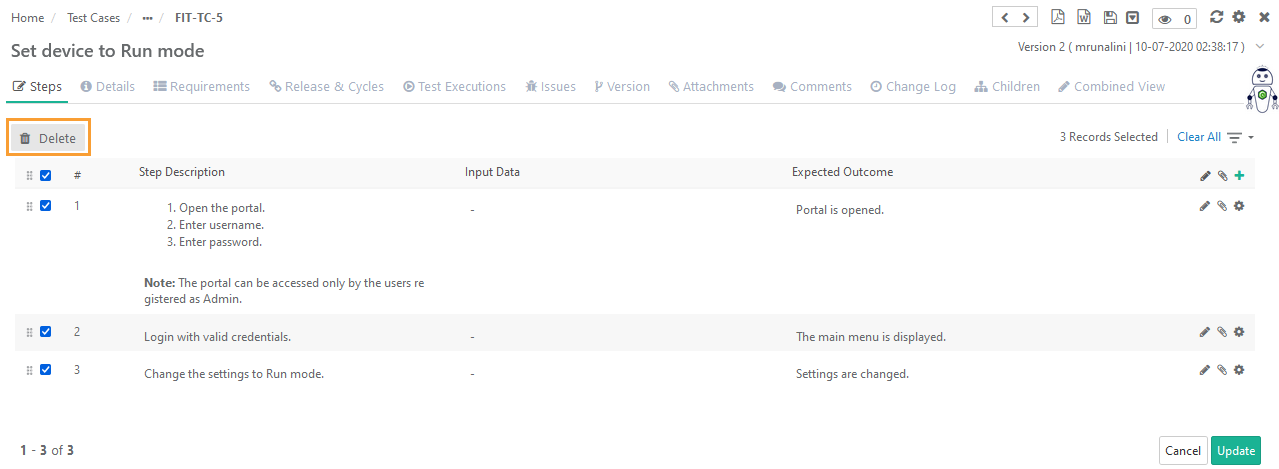
If test case steps are added or edited in the test case, which is already executed, then it is recommended to save the test case with Save as New Version.
If the User Role has Versioning rights (in Customization > Roles), then the button will be visible to the user. When you edit test case details, you can save the details with a new version of that test case.
Follow either (A) or (B) as mentioned here.
A. Click on the Con icon for the test case and select Create New Version.
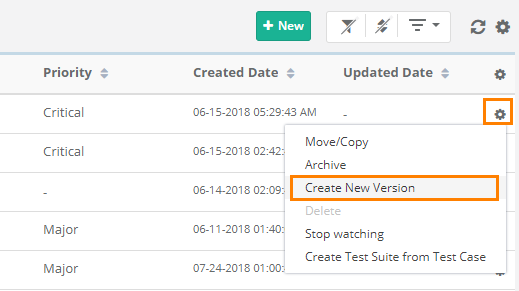
B. Open the test case detail page and click on the Create New Version icon on the header.

The next screen opens in editable mode.
Make required changes and click on the Save as New Version button to create a new version of the test case with updates.
If you add/edit test steps within a test case, it will ask you to create a new version of the test case to save the content of steps along with test case parameters. The associated test suite will still be associated with the previous version of the test case.
If the test case was executed before, then the following option is provided while saving the new test case version.
Auto sync latest version of Test Case in all executions: If the option is selected, then the test case version gets updated and its execution status is reset to “Not Run” on the Test Run screen.
Example: TC1 has execution status “Passed” in TS1. User modifies TC1 details and selects this option to reset the test case execution status while saving TC1. Now TS1 will show TC1 execution status as “Not Run”.
If the above option is not selected, then on the Test Run screen the sync icon appears beside the current version of the test case. On the Test Execution screen, to execute the latest version of the test case, click on the sync button.
The confirmation message pops up confirming the reset of execution status. The synced version will not show previously linked issues.
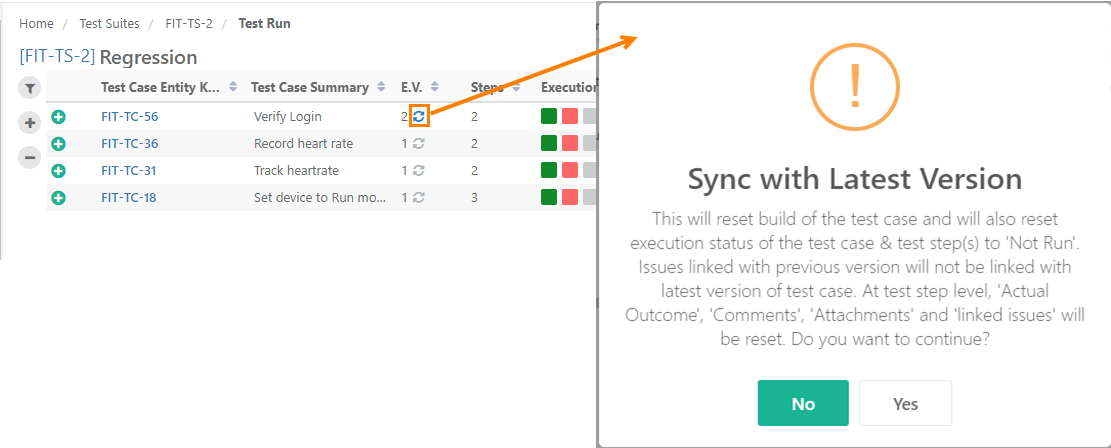
After syncing the test case with its latest version, its Execution Status changes to "Not Run".
If test steps were added in the latest version of the test case, then these test steps will also be added on the execution screen.
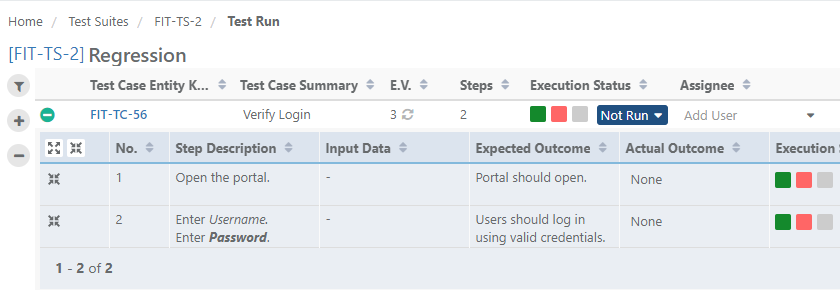
Note: QMetry allows you to use different versions of a test case for testing. Read more about it on the Managing Test Case Versions page.
All the versions of the test case should be archived to delete that particular test case.
You can not carry out further operations like adding attachments, linking test cases, issues, and release - cycles on an archived test asset.
A. Archiving from Test Case detail page
B. Archiving from Test Case module list view
A. Archiving from Test Case detail page
Open the test case details page by clicking on the test case.
Click on the Archive icon on the top right corner of the page.
It will archive all the underlying versions of the test case.

B. Archiving from Test Case module list view
Open test cases module.
The test case list view opens with list of existing test cases within the project/folder.
Click on the Cog icon for the test case you want to archive and select Archive. The test case is archived after confirmation.
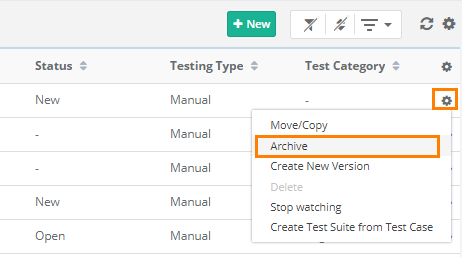
To unarchive an archived test case, click on the Unarchive icon at the top right corner.
Read Archiving a Specific Test Case Version
To delete a test case, first you need to archive it. All the versions of the test case should be archived to delete that particular test case.
It is a two step process:
Archive a test case (All the versions of the test case will be archived.)
Delete a test case (The test case will be deleted including all its versions.)
All the versions of the test case should be archived to delete that particular test case.
A. From Test Case detail page
B. From Test Case list view
A. From Test Case detail page
Open the detail page of the archived test case. Use the filter on the tree, to view the archived test cases.
Click on the Delete icon at the top right corner of the screen.
Once the test case is archived, it looks like below.

The Delete icon now appears at the top right corner of the page.
Confirm the operation on the pop-up.
B. From Test Case module List view
To view the archived test cases on the screen, select the Show Archived Items check box above the grid.
It displays archived test cases along with other test cases.
Click on the Cog icon for the archived test case and select Delete.
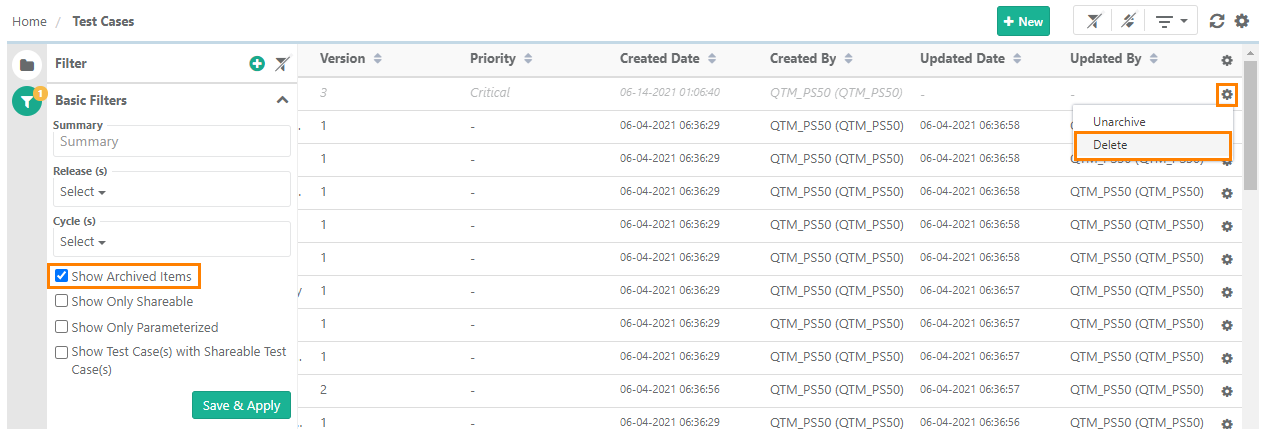
Read Deleting a Specific Test Case Version
Share Test Cases
Users can share the test cases with other users over email. The recipient user will receive an email containing a test case summary with the Message written while sharing the test case and a link navigating to the particular test case. It helps the recipient users easily access the latest version of test cases.
Steps
Open the test case details page.
Click on the Share icon at the top. The Share pop-up opens.
Enter the Email Address of the user with whom you want to share the asset. You can mention multiple email addresses to share the test asset with multiple users at a time.
Enter the required message that you want to convey to the recipient of the email.
Click on the Share button.
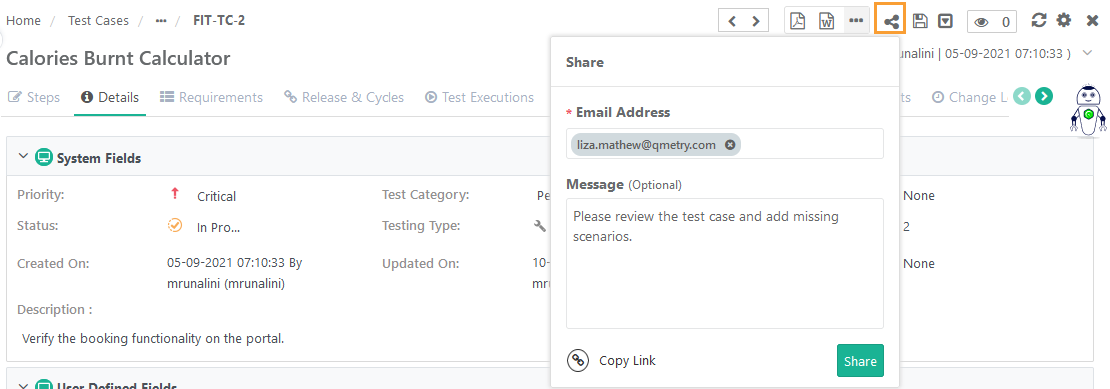
Copy Test Case Link
You can copy the link of the test case to share it further with other team members. It helps you to get the specific test cases and share it with other users through email or chat. The other users with whom the link is shared can access the test case directly from the link.
→ The following is the syntax of the URL:
https://<URL>>/#/<AssetType>/<AssetKey>
For example,
https://qtmtest.qmetry.com/#/test-case/FIT-TC-1751
Steps
Open the test case details page.
Click on the Share icon at the top. The Share pop-up opens.
Click on the Copy Link button.
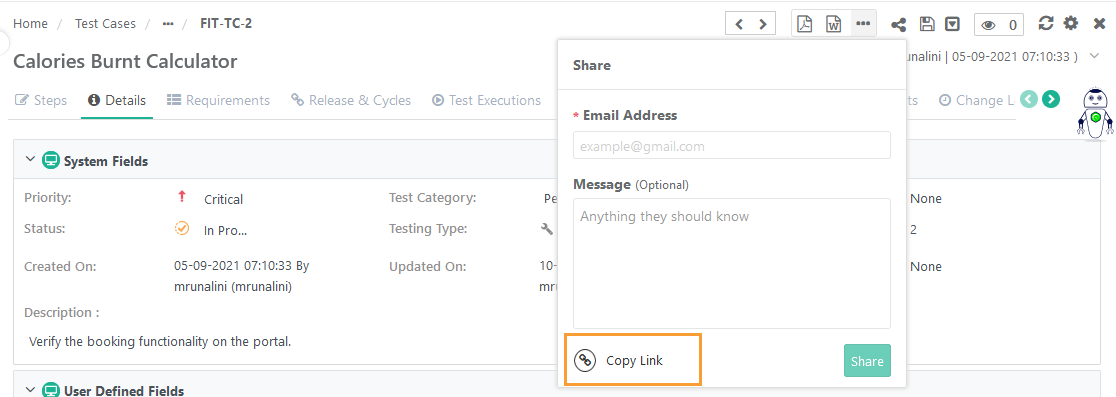
The test case link gets copied to the clipboard. You can share this link with other team members, whom you want to work on the test asset, either through email or chat or any other communication means.

Read Bulk Operations
You can link requirements with their relevant test cases. You can link a requirement to a test case only once. When a requirement is linked to a test case, it is linked with all versions of that test case.
When a requirement is linked to a test case, it is linked with all versions of that test case.
Use Case: Users link requirements with related test cases for testing. Testers get the idea of what is developed by studying requirements and on that basis, they write test cases to describe how to test the developed application. Thus, linking the test case with the requirement gives relevance between the two what is developed and what to test.
Requirements can be linked to the test case through the Requirements tab available on the Test Case details page and Test Case edit screen.
You can resize columns, apply sorting on columns (other than multi-lookup lists), and show/hide columns using the Arrange Columns option.
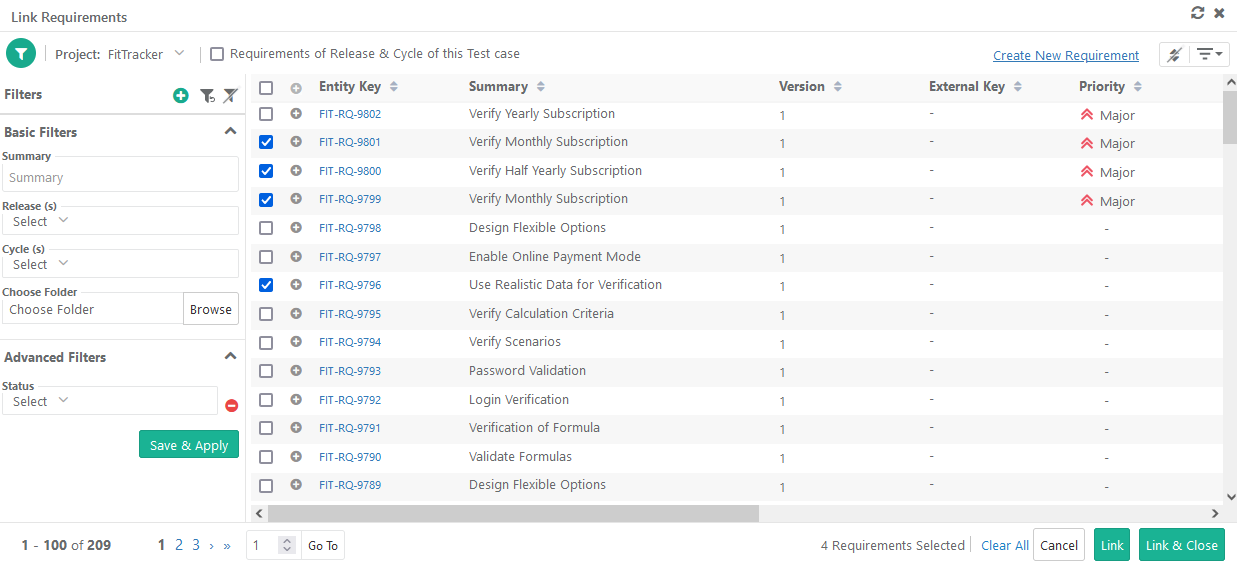
Steps
Go to the Requirements tab of the test case details page or requirement edit page.
Click on the Link button.
It opens the Link Requirements pop-up with the list of test cases on it.
Selecting Requirements Across Projects:
Users can link requirements from other projects as well. The Project drop-down is provided to select the project. The requirements for the project are displayed on the screen.
You can select a particular Version of the requirement to link to the test case. Requirements with multiple versions are expandable.
Use Case: Each version of the requirement is expandable so that users can view details of all versions in one place.
Expand the requirement and select the required version to link with the test case.
Filter: When you click on Filter, it displays multiple criteria to filter the records within and across projects. Labels and Folder path filters are also added for the ease of searching the records.
Requirement of Release & Cycle of this Test Case: The Checkbox will not be available when you are viewing test assets of other projects. Select the check box to view only those test cases that are associated with the same Release and Cycle to which the test case is linked.
You can resize columns, apply sorting on columns (other than multi-lookup lists), and show/hide columns using the Arrange Columns option.
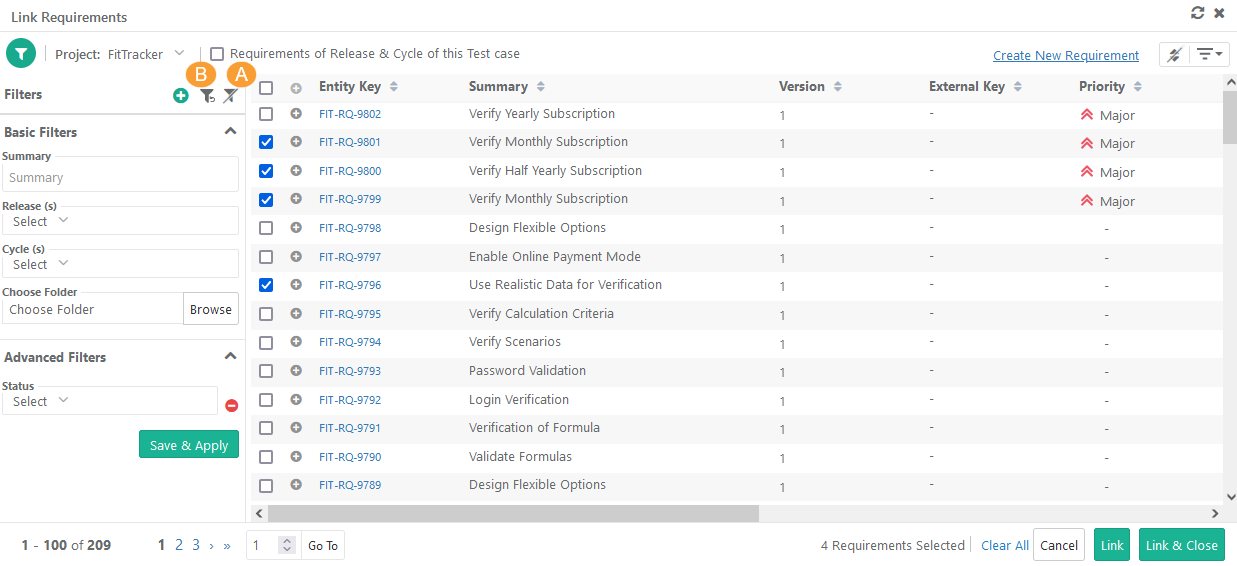
If you want to link requirements from multiple projects, then first select one project. Search records and link them before moving to other projects. For example, User A is in Project 1 and searches for some records and links them before moving to Project 2. Otherwise, all the selections of Project 1 will be wiped off.
A. Linking a Single Requirement: Click on the Link icon to link the individual requirement to the test case.
B. Linking Multiple Requirements: Select the requirements that you want to link and click on the Link Selected Requirements button at the bottom.
The selected requirements are linked to the test case. The linked requirement records are shown on the lower grid pane.

If requirements from other projects are linked, then the requirements show Entity Key of the corresponding project.
To view the requirement of other projects, click on the Requirement Entity Key. It opens the requirement detail page in the respective project and will change your current project.
The feature allows you to link the latest version of the requirement to a test case using the requirement key separated by a comma. Maximum 500 entities can be linked at a time.
Use Case: The feature is useful to link requirements to a test case without searching them individually. For example, users have the list of requirement keys to be linked to a test case, they can use this option to link the requirements directly. This feature will save the users' time in searching requirements in different folders to link them.
Notes:
Requirement key will be ignored if a relevant requirement with that key is not found.
If a single key is mentioned multiple times, it will be linked only once.
If an older version of the requirement is already linked and you are linking the same requirement key, then the latest version will not replace the older version. It will be skipped.
Archived versions will be skipped from linking. Only the latest unarchived version of entities will be linked.
Steps
Go to the Requirements tab of the test case.
Click on the Link By Entity Key button.

3. It opens the Link Requirements pop-up. Mention comma-separated Requirement keys.
4. Click Link.
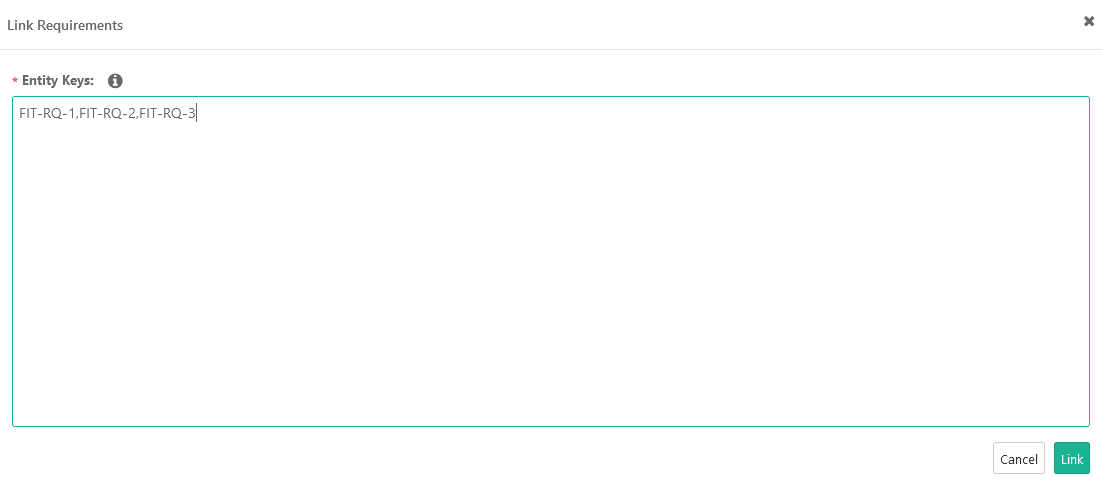
The requirements with mentioned keys get linked to the test case.

Open the Requirements tab on the test case details page.
A. To unlink a single requirement, click on the Unlink icon for the requirement. The requirement is unlinked after confirmation.
B. To unlink multiple requirements, select the requirements you want to unlink from the test case and click on the Unlink Selected button.

You can sync the latest version of the test case to its linked requirements individually or in bulk. The sync feature in the Test Case > Requirement tab allows you to sync the test case version with individual requirements or with multiple requirements in bulk.
For example, the current version of the test case is v2. All the requirements are linked to this version of the test case. Now, a new version of the test case is created i.e., v3. Users can sync the v3 of test case with the linked requirements.
(A) Sync Latest Test Case Version with a Single Requirement
When a new version of test case is available, the sync icon under the Test Case Version column turns Blue in color. You can just click on the icon to sync the latest version of the test case with the requirement in the row.

(B) Sync Latest Test Case Version with Multiple Requirements in Bulk
When there is a new version is available for the test case, the sync icon under the Test Case Version column turns Blue in color. Select the requirements to which you want to sync the latest test case version and then click on the Sync Latest Version of Test Case button.

After following (A) or (B) above, the confirmation message pops up.
Click Yes to proceed.
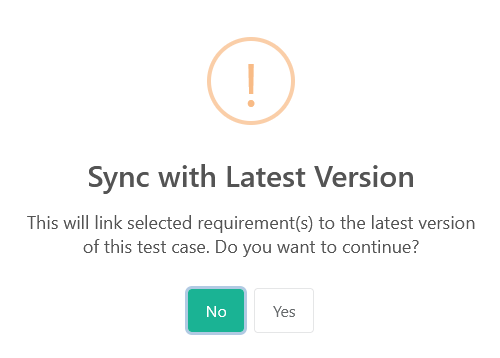
The success message appears.
For bulk sync, the progress will be shown in the Scheduled Task.
You can see the selected requirement(s) are synced with the latest version of the test case.

You can link test suites with relevant test cases for testing. QMetry allows users to link test suites of multiple projects to a test case. Test Suites can be linked to test cases through the Test Executions tab available on the Test Case details page and Test Case edit screen.
Test Suites are linked to the test case in multiple Platforms associated with it.
Selecting test suites Across Projects:
Users can link test suites from other projects as well. The Project drop-down is provided to select the project. The test suites for the project are displayed on the screen.
You can apply multiple criteria to filter test suite records within and across projects.
Note: Users should have 'Modify' rights of the Test Suite module in the targeted project from which the test suites are being linked.
Open the Test Executions tab and click on the Link Test Suites button. It opens the Link Test Suites pop-up.
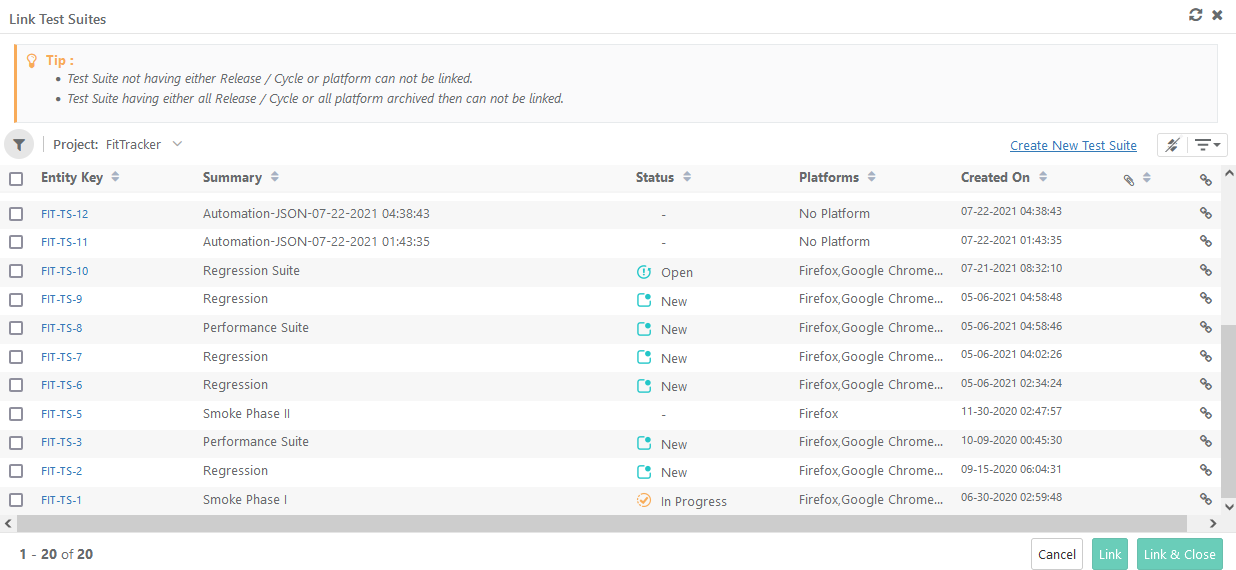
If you want to link test suites from multiple projects, then first select one project. Search records and link them before moving to other projects. For example, User A is in Project 1 and searches for some records and links them before moving to Project 2. Otherwise, all the selections of Project 1 will be wiped off.
A. Linking a Single Test Suite: Click on the Link icon to link the individual test suite to the test case.
B. Linking Multiple Test Suites: Select the test suites that you want to link and click on the Link Selected Test Suites button at the bottom.
The selected test suites are linked to the test case. The linked test suite records are shown on the Test Executions tab on the test case details page.
A. Clear Filter Values
The Clear Filter Values option provides users with improved flexibility, efficiency, and usability in managing and reusing Advanced Filters for important data that may not be easily accessible by default. This option only clears out the values in the filters without removing the fields themselves. It enables users to start fresh with the same set of fields, allowing them to adjust their filter criteria without having to recreate the entire filter setup each time. It preserves empty fields in the filter just like fields with values and allows users to easily modify and refine the filter criteria without losing the content of the set fields. Here, empty fields in the filter will consider all records.
B. Reset Filters
The Reset Filters option will reset the filter to default. All the selected fields for Advanced Filter will be removed from the filter.
You can resize columns, apply sorting on columns (other than multi-lookup lists), and show/hide columns using the Arrange Columns option.
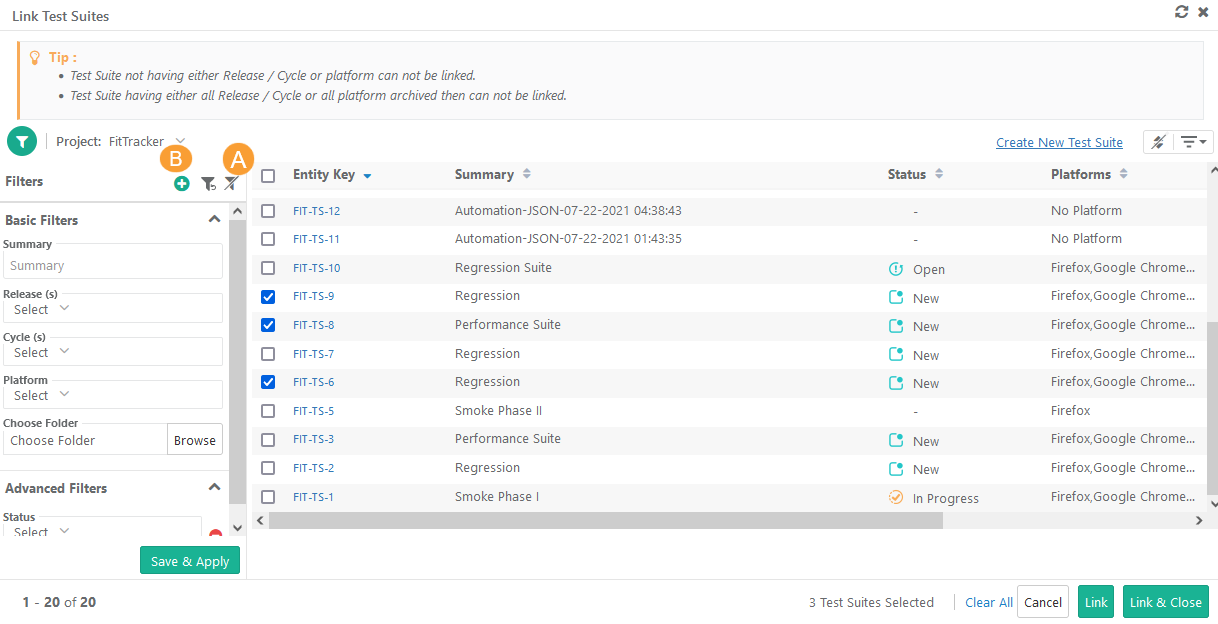
View Archived Test Runs
An execution/test run is archived when either Platform/Release/Cycle/Test Suite is archived. When a test suite, platform, or Release/Cycle is archived, the test executions having such test suite/platform/release/cycles associated with them will be hidden on the Test Executions tab of the test case.
The Show Archived Records check box is provided on the Test Executions tab. To view the test runs that are archived due to platforms/release/cycles, select the check box in the filter.
While importing any change in the status of such archived test case executions will be ignored.
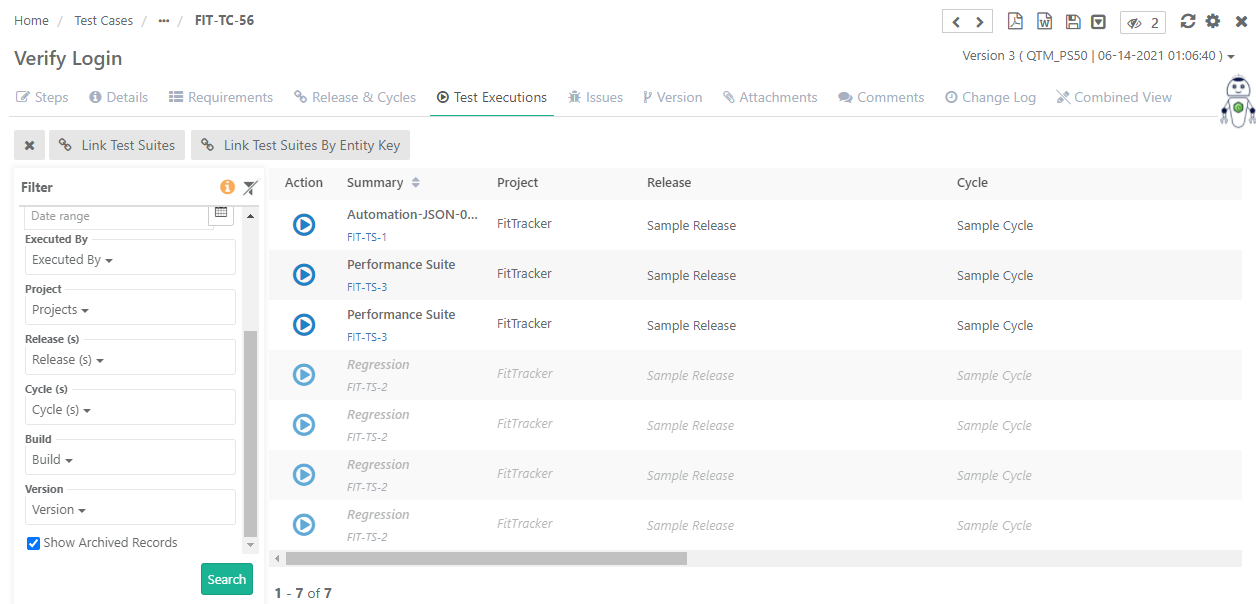
If test suites from other project are linked, then the test suites show Entity Key of the corresponding project.
To view the test suite off other project, click on the Test Suite Entity Key. It opens the test suite detail page in the respective project and will change your current project.
In case of eSignature feature:
eSignature in current Project | eSignature in Test Suite Project | Can test suites be linked with the test case? |
|---|---|---|
disabled | enabled | No (The Project drop-down on the Link Test Suite screen will only show those projects which have eSignature feature disabled) |
disabled | disabled | Yes |
enabled | enabled | Yes |
enabled | disabled | Yes |
If the eSignature feature is enabled in the Project -
Test Case Status | Can test suites of any project be linked with the test case? |
|---|---|
Approved | Yes |
In Review | No |
Link Test Suite Bulk Operations
You can link test suites from multiple projects also through Test Case Bulk Operations.
All scenarios mentioned above also apply to the bulk operation of test cases.
You can link test suite to test cases through -
Test Case module > Bulk Operations > Edit > Select Records > Link Test Suites.
The feature allows you to link test suites to a specific version of test case using test suite key separated by comma. Maximum 500 entities can be linked at a time.
Use Case: The feature is useful to link test suites to a test case without searching them individually. For example, users have list of test suite keys to be linked to a test case, they can use this option to link the test suites directly. This feature will save the users' time in searching test suites in different folders and link them.
Notes:
Test Suites key will be ignored if relevant test suite with that key is not found.
If a single key is mentioned multiple times, it will be linked only once.
Archived test suites will be skipped from linking. Only unarchived version of entities will be linked.
Skip Duplicate Linkage is "On": If the test case is already linked with a test suite, then the linked test suite will be skipped. Only those test suites will be linked which are not yet linked with the test case version from where the linking is being performed.
Skip Duplicate Linkage is "Off": The test case version from where the test suite is being linked, that version will get linked to all the test suites.
Steps
1. Go to the Test Executions tab of the test case.
2. Click on the Link Test Suites By Entity Key button.

3. It opens the Link Test Suites pop-up. Mention comma-separated Test Suite keys.

The test suites with the mentioned keys get linked to the test case.
The Test Executions tab shows the last execution build for the test suite. It is useful when a QA Manager/Tester wants to see the latest Build against which the execution was done on the 'Test Executions' tab of the Test Case screen.

Test run logs to test cases are attached at the test run level. These logs are available to view and download on the Test Executions tab of the test case details page. If a test suite has an attachment(s) attached to it, then the Attachment icon is displayed in Blue color for that test suite. Only test case-level attachments will be displayed here.
The attachments at the test run level are displayed to provide more in-depth information on test case execution. Users can get the execution details of the test case on the same screen.

Click on the Blue attachment icon. It opens the Attachments pop-up as below.

Open the test case detail page and open the Test Executions tab. Users can view Execution Time and Remaining Time calculated for Test Execution.
Use Case: Calculation of Execution Time and Remaining Time for the test suite is useful for the QA Manager in Test Planning as it gives accurate estimates for the test suite. These test case level estimates are refined each time a test suite is executed. Testers can make recommendations to have the test estimates revised based on the last few executions in different environments.
Two columns Execution Time and Remaining Time are added to the grid at the following places in the application:
Test Suite detail page > Test Executions tab
Test Case detail page > Test Executions tab
Issue detail page > Execution Runs
Calculation of Execution Time of a test suite:
The Execution Time of a test suite is calculated based on the Estimate Time of all the test cases in that test suite.
Calculation of Remaining Time of a test suite:
Once the test suite is executed, the Remaining Time Is calculated for all “Not Run” test cases. Any test case with “Failed” or “Blocked” status will also be considered as the work still remains on it.
The Remaining Time will be reduced for test cases with “Pass” and “Not Applicable” status accordingly.
Example
The following example shows the calculation of both – Execution Time and Remaining Time.
Execution time | Status | Remaining time | |
|---|---|---|---|
TC1 | 2 | Pass | - |
TC2 | 3 | Not Applicable | - |
TC3 | 4 | Failed | 4 |
TC4 | 5 | Blocked | 5 |
14 | 9 |
Execution Time = 14
Remaining Time = 9
The Issues tab on the test case details tab shows all the issues linked to the test case from the test execution screen.
You can link issues directly to the test case without executing the test case through test suites. It makes the tracking of issues related to the the test case easier. You can link internal as well as external tracker issues to test cases.
Use Case: Testers are confirmed that the issues are related to a particular test case, and they don't want to execute the test case just to link those issues to it. Hence, they want a way to directly link issues to a test case.
On test case list view, the Linked Issues Count for the test case will show unique count of issues linked to the test case - issues linked directly or through execution.
Steps:
1. Go to the Issues tab of the test case details page or test case edit page.
2. Click on the Link button.

It opens the Link Issues pop-up with the list of issues.
You can resize columns, apply sorting on columns (other than multi-lookup lists field type), and show/hide columns using the Arrange Columns option.
In the case of linking issues from Jira:
The Advance Filter option is also available for the custom fields that are configured/mapped for the Issue module in Projects > Integration.
The Arrange Columns option will show all the system and custom fields that are configured/mapped for the Issue module in Projects > Integration.
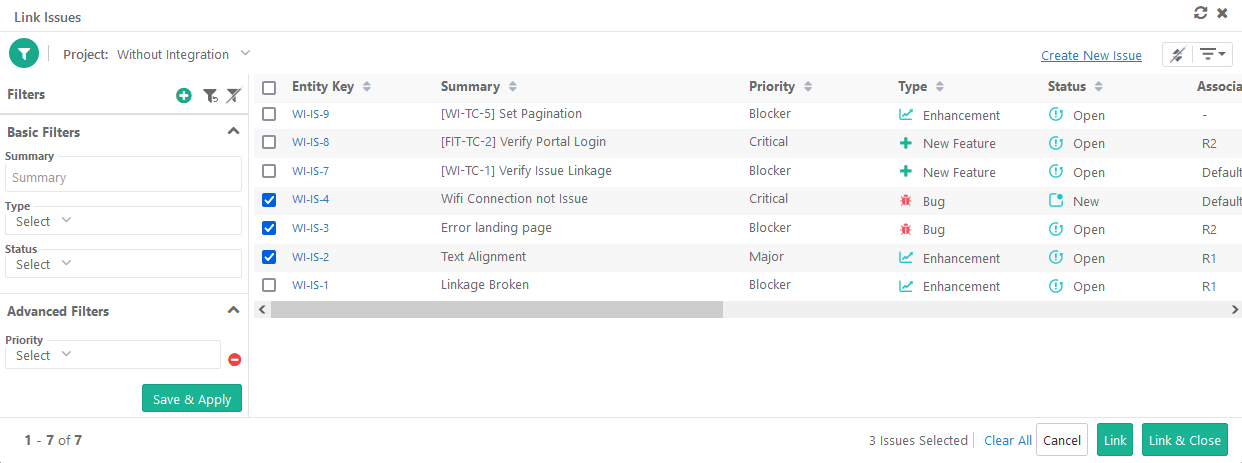
You can apply Basic Filters as well as Advanced Filters on the Link Issues screen, which allows quick filter of test cases to link with the requirement.
You can easily filter test cases by any system/custom fields for the ease of narrow down the search for required issues.
(A) Basic Filters: By default, basic filter fields are provided to filter the records.
(B) Advanced Filters: If you need more fields to filter test assets then click on the '+' icon. It opens the drop-down with a list of additional system and user defined fields corresponding the module.
Select the field you want to apply the filter on. The filter parameter is added as Advanced Filters. Apply filter as per your requirement.
A. Clear Filter Values
The Clear Filter Values option provides users with improved flexibility, efficiency, and usability in managing and reusing Advanced Filters for important data that may not be easily accessible by default. This option only clears out the values in the filters without removing the fields themselves. It enables users to start fresh with the same set of fields, allowing them to adjust their filter criteria without having to recreate the entire filter setup each time. It preserves empty fields in the filter just like fields with values and allows users to easily modify and refine the filter criteria without losing the content of the set fields. Here, empty fields in the filter will consider all records.
B. Reset Filters
The Reset Filters option will reset the filter to default. All the selected fields for Advanced Filter will be removed from the filter.
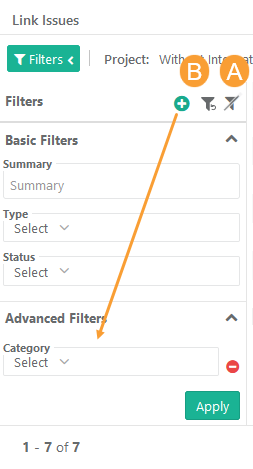
Selecting Issues Across Projects:
Users can link issues from other projects as well.
The Project drop-down is provided to select the project. The issues for the project are displayed on the screen.
Select issues that you want to link to the test case.
The Filters will populate only for the selected Project.
If you want to link issues from multiple projects, then first select one project. Search records and link them before moving to other projects. For example, User A is in Project 1 and searches for some records and links them before moving to Project 2. Otherwise, all the selections of Project 1 will be wiped off.
3. Select the issues you want to link with the test case and click on the Link button.
→ Create New Issue: The link is available when you have selected current project on the drop-down. To create a new issue click on the Create New Issue link at the top right corner of the pop-up. It opens Issue module in a separate tab, wherein you can create more issues. Then refresh the Link Issues pop-up to view the newly created issues on the list.

The issue is linked to the test case and is displayed on the Issues tab on the details page.
Issue Traceability in Test Case
In the Test Cases module, the issues tab displays issue linked to the test case either directly or indirectly through execution of the test case.
To view the issue of other project, click on the Issue Entity Key. It opens the issue detail page in the respective project and will change your current project.
You can identify whether the issue is linked from execution screen or from the test case detail page by looking at the Direct Linkage and Execution columns.

→ Direct Linkage column:
If the issue is linked from the test execution (i.e. issue linked while execution of the test case), then the Direct Linkage shows “No”.
If the issue is directly linked to the test case, the Direct Linkage shows “Yes”.
Issues which are linked from executions, can be unlinked from the execution screen.
→ Execution column:
The Execution column on the Test Case > Issues tab shows the count of test executions the issue has been linked to.
Clicking on the count opens the Execution Runs pop-up with execution details of the issue, executed Platform, Release, Cycle, Linkage Level, etc.
The Linkage Level column shows the issue is added on test case level or test step level on the execution screen.

If the test case is associated with a requirement, then the issue directly linked to the test case will also appear on the Issues tab of that associated requirement.
→ When Jira is integrated with QMetry -
If an issue from Jira is directly linked with the test case, it will appear in the Issues tab of the test case.
In Jira, the test case details will appear in the Test Case section of the linked Jira issue. The Test Case Steps tab will display step details of the test case. The Executions tab will remain blank as the Jira issue is linked with the test case without its execution.
On the Jira add-on page, the Test Case Details tab will display all the details, while the Executions tab will appear blank.
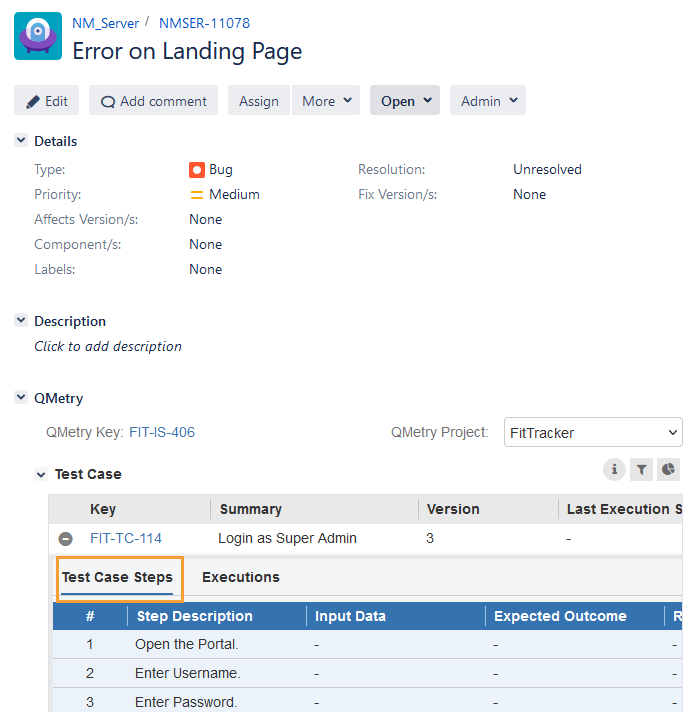
Release and Cycle can be associated from the test case detail page as well as the test case edit page.
The tab allows users to associate release and cycle to the test case. One test case can be associated with multiple releases and cycles. Release and Cycles are added from Projects > Project/Release/Cycle.
Once the test case is added, the user wants to add it to a particular Scope - release and cycle. For this reason, they edit the test case and associate the new release and cycle to it.
Click on the Add New button to associate release and cycle with the test case. The drop-downs are enabled by clicking on the Add New button.
Select the release(s); the cycle list is prompted for the selected release.
Select the cycle(s).
Select the version of the entity to associate as you can link releases and cycles to a particular version of the test case.
Click Save.
The associated release and cycle appear in the grid on the screen.
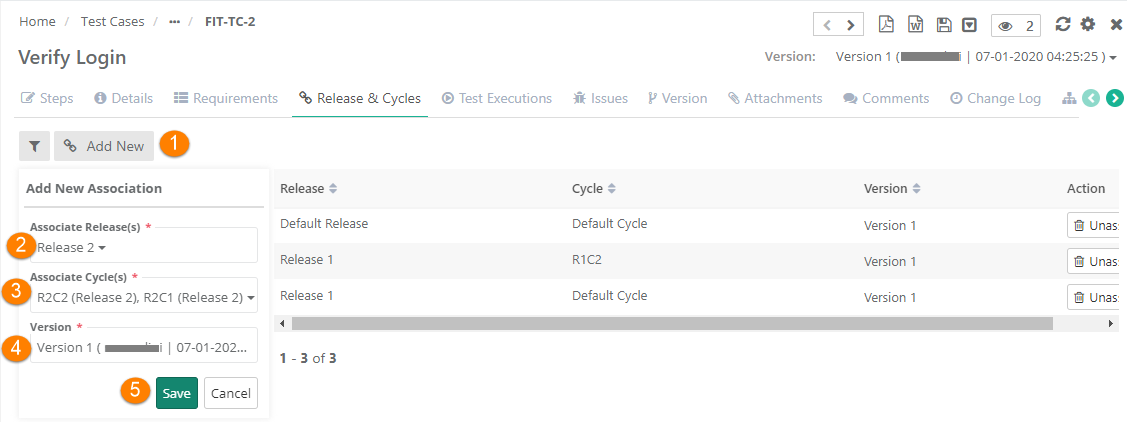
To remove the release and cycle association for the test case, click on the Unassociate button for the release and cycle combination.
Read about Test Case Versions
Read about Change Log
Read Exporting Test Cases
Read Exporting Test Cases
Tip #1: Before Adding test cases establish rules to how test cases are to be designed, categorized, and organized. QMetry comes with a number of system fields. All of the fields, along with the folders can help teams better manage their test cases. In addition, the Status field can be used to create a workflow to improve the development of the test cases from "New" to "Approved".
Tip #2: QMetry allows testers to provide actual results and record status at a test case level which may change how you design test cases moving forward. Teams should properly define how and when to add test case steps.